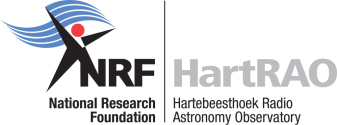
HartRAO Home > Spectra Contents > Spectra Introduction
In the the space between the stars are found clouds of gas, from which the stars formed. These clouds consist mainly of the simplest atom, hydrogen. More massive atoms such as carbon, oxygen and nitrogen are created within stars by nuclear fusion. These atoms are returned to space in the winds given off by stars and when stars explode. The atoms can combine chemically to form many sorts of molecules, such as water (H2O), carbon monoxide (CO) and ammonia (NH3).
Several types of atoms and molecules produce emission lines at specific frequencies in the centimetre wavelength band which are observable with the Hartebeesthoek radio telescope .
Here we describe:
Molecular Clouds
Formaldehyde (HCHO) is also common in molecular clouds. It is normally seen as an absorption line at 4829 MHz in the 6cm wavelength band. It is found in the denser parts of molecular clouds.
 Examples of spectra and more information on hydroxyl and
formaldehyde from a molecular cloud showing lines both in emission and in
absorption are given here.
Examples of spectra and more information on hydroxyl and
formaldehyde from a molecular cloud showing lines both in emission and in
absorption are given here.
The dense cores of the molecular clouds can collapse under their own
weight to form new stars. If the newly formed star has more
than eight times the mass of the sun, it produces sufficient radiation to
excite very strong stimulated emission at radio wavelengths, known as a
maser, from molecules such as hydroxyl in
the surrounding clouds.
In addition to intense masers from the four ground state lines at 18cm
wavelength, hydroxyl masers are known to occur in lines
from excited states. These include the three lines at 4660, 4750 and 4765
MHz in the 6 cm wavelength band and the four lines at 6016, 6030, 6035 and
6049 MHz in the 5 cm wavelength band. These transitions are all observable
at Hartebeesthoek. In 1987 strong masers were also found to be generated by methanol
(CH3OH, the simplest alcohol) molecules in star-forming regions, at
a frequency of 12178 MHz in the 2.5 cm wavelength band.
Even stronger methanol masers were discovered in 1992.
These occur at 6668 MHz in the 4.5 cm wavelength band. Several hundred have
been discovered since then, many of them with the Hartebeesthoek telescope.
The ultraviolet radiation from these massive stars splits the atoms of
neutral hydrogen gas (HI) in the surrounding cloud into
their constituent protons and electrons, creating a steadily growing
ionized hydrogen cloud, or HII region. A
few thousand of these objects are known within our galaxy, well-known ones
including the Orion and Rosette Nebulae. The ionized
hydrogen is hot, with a temperature of 5000-10000 K. HII regions produce a series of emission lines from
the protons and electrons as they recombine to form hydrogen atoms in
excited states. These hydrogen recombination lines are
generally broad and weak, owing to the high temperature of the gas. They occur at
regular intervals throughout the radio spectrum.
For most of their lives, stars produce no detectable radio emission
lines. However, in their old age they become unstable, swell and pulsate
slowly. The first time this occurs is as an irregularly variable
supergiant star. Later they evolve into asymptotic
giant branch stars which have regular pulsations. These are named
Miras (miraculous), after Mira (omicron Ceti), the first
star in which the large changes in brightness caused by the pulsations was
identified. These stars are highly enlarged and relatively cool. They are
red hot rather than white hot like the sun, and appear orange or red to the
eye.
In the final stages of their lives the stars expel their outer layers,
which form planetary nebulae. These are so called because
the shell of hot gas around the star can look like a planet through an
optical telescope. The remains of the central star collapses to become a
white dwarf star. Just before this occurs, the Mira-type pulsations stop and
unusual hydroxyl maser profiles are seen from the rapidly evolving shell of
gas and dust as it detaches from the star.
Translation into Russian:
radiospektrkopiyu.
Masers in Star-forming Regions
 These spectra show the rapid variations that were
discovered in one methanol maser during monitoring with the Hartebeesthoek
telescope.
These spectra show the rapid variations that were
discovered in one methanol maser during monitoring with the Hartebeesthoek
telescope.Recombination lines from Ionized
Hydrogen
 Spectra of recombination lines. Lines observable at
Hartebeesthoek include the H157alpha line at 1683 MHz, the H141alpha line at
2321 MHz and the H110alpha line at 4874 MHz.
Spectra of recombination lines. Lines observable at
Hartebeesthoek include the H157alpha line at 1683 MHz, the H141alpha line at
2321 MHz and the H110alpha line at 4874 MHz. Masers from Evolved Stars
 These spectra show the
maser emission that can occur from
hydroxyl molecules in the winds blowing away from
Mira-type stars.
These spectra show the
maser emission that can occur from
hydroxyl molecules in the winds blowing away from
Mira-type stars.
Translation into Portuguese: https://www.homeyou.com/~edu/introducao-espectroscopia-de-radio